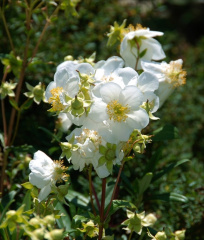Showcase Feature
Mary, who has been attending the Bringing Back the Natives Garden Tour since its inception in 2005, was ready to get rid of the juniper-heavy ‘50s-style landscape. Inspired by the Tour, she hired Pete Veilleux of East Bay Wilds to design and install a garden that looked more natural, and would attract wildlife. Out went the junipers, and in came an artistic and fun front garden a containing a variety of attractive water-conserving native plants selected to provide color throughout the year and also to attract birds, bees, and butterflies.
Undulating and meandering berms provide the drainage that many native plants need, and help keep rainwater on-site. Sonoma basalt boulders, mixed yellow and blue decomposed granite, and driftwood create visual interest.
Other Garden Attractions
- Don’t miss the low-tech, inexpensive gravity-fed water feature (check out the one-gallon bottle tucked behind the California lilac).
- A redbud softens the lines of the house.
Gardening for Wildlife
The native plants, water feature, and bird feeder attract white-crowned sparrows, house finches, and scrub jays. Recently a bluebird (not a jay—the bluebird is a cavity-nesting bird that is declining in population) was seen bathing in the fountain. Bees love the sages and hummingbirds adore the California fuchsia. Salamanders hide in the leaf litter that is left to compost under the trees. Two gravity-fed drip fountains provide water for wildlife.
Native Plant Greeting Cards for Sale!
Mary, a talented artist, has created a series of beautiful native plant greeting cards, which will be available for sale on Saturday, May 4 (cash only): proceeds will benefit the Tour. Check them out!
Keystone species in this garden
Butterflies and moths will only lay their eggs on certain plants, which are called larval host plants. Their eggs become caterpillars, which almost all baby birds must have while they are in the nest. Without caterpillars, we will have no baby birds. Larval host plants in Mary’s garden include lupines, manzanitas, sages, California lilacs, buckwheats, sunflowers, snowberries and clarkias, among others.
Watch this great talk by Douglas Tallamy to learn more!
Garden talks
11:00 and 2:00 “”How to make a gravity-fed drip fountain” by Mary Cooper
Great Recipe!
“Here is a recipe for Cashew Basil “Cheese” that my drawing class always enjoys when it’s my turn to provide snacks,” Recipe provided by garden tour host Mary Cooper.
Cashew Basil “Cheese”
Video
“Gardening with California native plants” by Mary Cooper
Photos
Click to see as a slideshow:





















